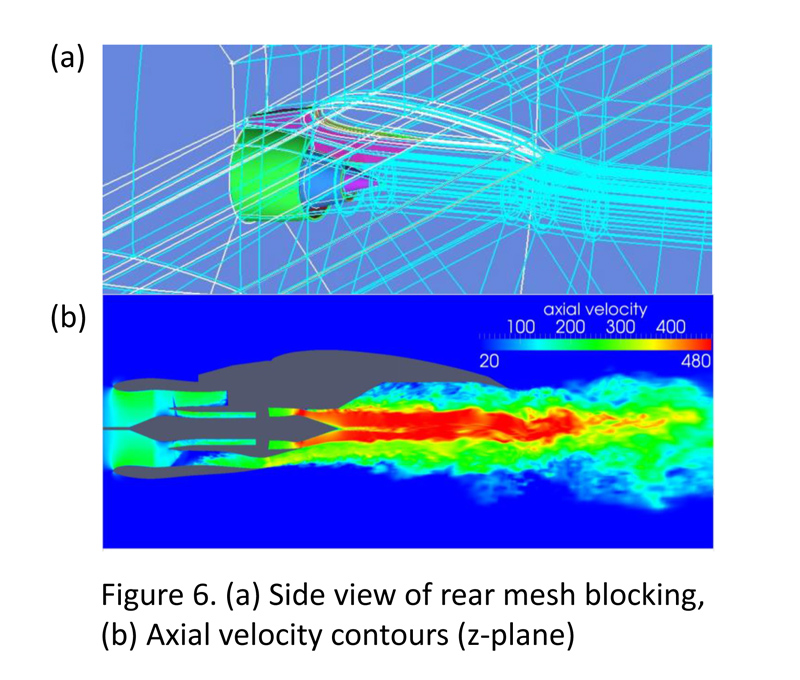ENGINEERING AND CFD
Aerodynamics and Aeroacoustics of Complex Geometry Hot Jets
Principal Investigator:
Richard Jefferson-Loveday
Affiliation:
The University of Nottingham (U.K.)
Local Project ID:
PP13081626
HPC Platform used:
Hermit of HLRS
Date published:
The computing time on HLRS supercomputer Hermit has been used to perform highly intensive Large Eddy Simulations (LES) of complex geometry jets. The major emphasis has been to use the LES CFD approach (Computational Fluid Dynamics) to enable improved prediction and to generate the necessary complex unsteady flow fields needed for acoustic modelling.
With the projected demand for air transport set to double the world aircraft fleet by 2020 it is becoming urgent to take steps to reduce the environmental impact of take-off noise from aircraft. In worst case noise can be more than just annoying, potentially being a contributory factor towards illnesses such as hypertension [1]. Hence, the Advisory Council for Aeronautics Research in Europe (ACARE) has set the target of reducing perceived noise levels by 50% by the year 2020.
Large eddy simulations have been performed for hot jets with complex nozzles and for cases with flight streams. A co-axial jet with a pylon and wing simulation has also been performed. Hot jets are very sensitive to numerical dissipation and can exhibit lower numerical stability compared with cold. Excessive dissipation can lead to damping of resolved turbulence, hence here a kinetic energy conserving scheme [2] is used.

For the single stream jet cases the acoustic Mach number is 0.9 and the temperature ratio for the hot jets is 2.7. This set-up matches the experiments of Bridges [3]. For cases with flight stream the acoustic Mach number is set to 0.3. Figure 1 (a) shows instantaneous U-velocity plots for a hot jet without a flight stream and (b) with a flight stream. As can be seen with the presence of the flight stream increases the length of the potential core of the jet and decreases the jet spread rate. Mean flow centreline velocity plots are shown in Figure 2. The experimental measurements represent a consensus data from different nozzles (see Bridges [3]).

The simulation results for the no flight stream case show reasonable agreement with the consensus data and the increase in potential core length for the flight stream case is reflected in this plot. Figure 3 shows fourth order 2-point 2-time-correlations of the turbulent Reynolds stresses (the base point being located in the jet shear layer and two jet diameters downstream of the nozzle exit). These are crucial to the noise source modelling using the linearized Euler equation approach.

Initial far field pressure fluctuations have been calculated from the integral form solution of the FWH (Ffowcs Williams and Hawkings) equations. Cylindrical surfaces are placed outside the hot jets and a single disc is used to close the upstream end. Figure 4 shows directivity of the overall sound pressure level (OASPL). The simulated results are compared with new measurements from the QinetiQ facility (experiments unpublished work). However this approach is susceptible to contamination effects of pseudo sound as demonstrated at higher angles (>40 degrees).

Simulations of an oblique flight stream are similar to the experiments that were carried out at the QinetiQ Noise Test Facility (NTF). Flow conditions are set to be representative of full-power take-off certification conditions of a modern aero-engine. In order to achieve the flight stream incidence the feed pipe is turned upstream of the nozzle. Figure 5 (a) shows the mesh for an oblique flight stream case (b) velocity contours with a flight stream incidence of 8 degrees.

The coaxial jet nozzle with pylon, wing and flap geometry case is shown in Figure 6(a). This geometry is based on the COJEN coaxial jet nozzle and includes an intake, hub and splitter upstream. Internal geometry features (A-frame, OGV and gearbox shaft wakes) have also been added to examine their influence on jet development. The presence of the pylon and the wing introduce great complexity and intersect many O-grids. The total mesh size is 100 million nodes and the fan is modelled with an axi-symmetric body force model.

Figure 7 shows a short time mean of the axial Reynolds stresses both without and with internal geometry. For the case with the internal geometry higher turbulence levels are seen relative to without which in turn produces a more rapid thickening of the outer and inner shear layers. The data obtained during the project will be analysed for these cases to assess the importance of upstream geometry effects.

This project was made possible through the Partnership for Advanced Computing in Europe (PRACE) on HPC system Hermit of the High Performance Computing Center Stuttgart (HLRS).
References:
[1] M. Rosenlund et al. Increased prevalence of hypertension in a population exposed to aircraft noise. Occup Environ Med Vol. 58, pp. 769-773, 2001.
[2] A. Jameson. Formulation of Kinetic Energy Preserving Conservative Schemes for Gas Dynamics and Direct Numerical Simulation of One-Dimensional Viscous Compressible Flow in a Shock Tube Using Entropy and Kinetic Energy Preserving Schemes. Journal of Scientific Computing, Vol.34, No.2, 2008, pp. 188-208.
[3] J. Bridges, M. P. Wernet. Establishing Consensus Turbulence Statistics for Hot Subsonic Jets. 2010, AIAA 2010-3751.
Project Team:
Dr. Richard Jefferson-Loveday (The University of Nottingham)
Prof. Paul Tucker, Dr. Zhong-Nan Wang, Dr. Iftekhar Naqavi, Dr. James Tyacke, Dr. Mahak Mahak (The University of Cambridge)
Scientific Contact:
Richard Jefferson-Loveday
The University of Nottingham, Faculty of Engineering
Room A31b Coates Building
University Park, Nottingham, NG7 2RD/UK
e-mail: Richard.Jefferson-Loveday@nottingham.ac.uk